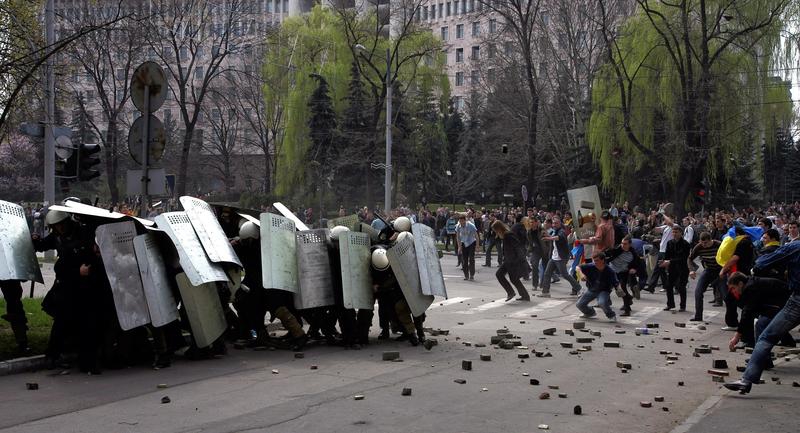
The interviewees’ conclusion was as follows: five years ago, the media outlets close to the government [of the time] covered the events of 7 April in a biased manner or did not cover them at all. The few media outlets that provided the public with correct and neutral information about the situation included only some newspapers, the Internet, and very few radio and TV channels.
Rodica Mahu, editor-in-chief of the newspaper Jurnal de Chisinau, who had been abducted on 10 April from the street by policemen in civilian clothes, remembers that back then there was very little free press. “Oleg Brega and reporters of Jurnal made versatile journalism in terms of the means used. They covered as much as they could.”
Rodica Mahu also said that many colleagues had a “servile” attitude towards the authorities at the time. “It was and still is an example of subservience, that attitude and performance of our colleagues from “state bodies”, who did not protest at all – neither at the level of institution, as individuals, or small groups. There was a kind of obedience to Voronin’s government. Everyone kept silence or told lies. I mean TVM [the state-owned television] and all other structures employed by the state.”
Analyzing reports that appeared in the media after 7 April, Rodica Mahu believes that journalists should make more efforts to clarify the situation. “After the five years that followed, beyond sensations, nobody tried too hard to find some truths (…). I wonder if we have done everything possible. Perhaps we should make a parallel investigation, about the things Nagacevschi’s commission failed to do?” Mahu said.
In his turn, journalist Oleg Brega, at that time reporter of the Jurnal TV channel, who was beaten by policemen on 8 April 2009 behind the Government building, criticized the manner in which the media covered the events of 7 April 2009. “Their coverage was not even biased; it was almost an act of complicity with the regime, keeping silence about illegalities, about the events in the square, which was a certain kind of manipulation and disinformation. In particular, they broadcast propaganda films produced by Constantin Staris. They said: “Look how bad the oppositions is; look at fascist occupants, American influence, Serbian terrorists coming”, etc.” In Brega’s opinion, Pro TV provided a balanced and neutral coverage, but it took little time, only in newscasts; Jurnal TV was mainly followed on the Internet, and newspapers were read very little.
Oleg Brega’s opinion about the media today is not good, either. “Today, we have more media, an explosion of radio stations and TV channels on the market, but most of them are controlled by moguls, who have links with politics, many of them close to the government. Although the media are more numerous and have more tribunes for expression, we even recently had an example when a tent camp was dispersed from the Great National Assembly Square with absolutely no journalist present,” Brega said.
Both Oleg Brega and Rodica Mahu filed lawsuits against the policemen who assaulted them. According to them, the policemen in question are still employed in the law enforcement: they had first been discharged, but later reinstated in their jobs.
The 7 April events have left a mark on journalist Vitalie Ciobanu, too. “It was a state of horror, terror and despair. We couldn’t believe that we were going back to the Soviet Union, into a military junta – it is what the regime was turning into, as Voronin first flirted with Europe, but then showed his fangs. Just like Putin is doing to the civilized world now,” Ciobanu said.
The journalist argues that the official media did not fulfill their professional obligations. “It was Voronin’s regime, the media were censored. At the time of protests in the center of Chisinau, which were followed by the use of force, the public television kept its regular broadcasting – children’s programs, concerts, as if nothing had happened,” the journalist remembers.
Vitalie Ciobanu believes that the Internet played one of the most important roles in informing the public. “I believe that it was rather unofficial media that made real press, which did not betray its mission and professional ethics. The most active and honest were the few independent newspapers, groups and teams of journalists, who reported from the site. The events became subjects of films, and photos and videos were used as evidence in courts. Nevertheless, only due to the Internet we could obtain the most correct and real information about the events at the time,” Vitalie Ciobanu underlined.
According to the study Monitoring Mass Media in the Post-Election Period: Coverage of Protests of 6 and 7 April by Moldovan Televisions, produced by the Independent Journalism Center in 2009, “the majority of the monitored televisions did not meet professional standards, having grossly violated the principles of professional ethics applicable to the coverage of conflicts.”
Most of the violations were found in the work of the three channels with national and quasi-national coverage (Moldova 1, Prime TV, and NIT) and one regional channel (N4). “Selective presentation of news, biased reporting on the motives and the course of events, citing one side of the story and failure to include alternative sources, manipulations with text and video – all these contributed to the fact that the viewers of Moldova 1, Prime TV, NIT and N4 had access to unilateral, biased information, presented from the perspective of central authorities,” the report says.
Source of photo: http://www.infoprut.ro/










